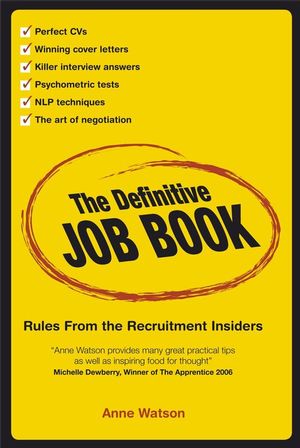The Definitive Job Book: Rules from the Recruitment InsidersISBN: 978-1-84112-781-1
Paperback
296 pages
January 2008, Capstone
 |
||||||
Dramatis personae.
The recruitment insiders.
Throughout the book you will fi nd words of wisdom and cautionary tales from recruitment insiders who will give you some insight on life from their side of the desk and what it means for you.
Introduction.
This is your personal head-hunting call.
How this book will help you.
Set the goal.
Look at the process.
It is not a job for life.
The choice to work where you want.
Start with who you are.
Tools and resources.
Talent spotters.
Chapter 1: The decision to move.
Result: call to action!
Fed up with your job: you know you need to move.
Redundancy and coping with the shock.
Walking out on your job.
And if you were fi red?
The graduate.
The best job for you.
Practicalities to consider.
Facing the fi nancial music.
The ‘Kevin Johnson personal business plan’.
Thinking of starting your own business.
The right job for you.
Jane Chapman’s ‘Who are you really?’
Identify your skills and experience.
Chapter 2: Crafting the perfect CV.
Result: the perfect marketing tool.
You are unique.
The fi ve stages of life.
The perfect CV.
No shortcuts.
The one that is too thin.
The one that is too fat.
The one that is just right.
The right one for you.
Creating a career data bank.
General rules for creating your ‘perfect’ CV.
Truth – the golden rule.
Technology to help you.
Updating your CV.
The e-mail address.
Spelling.
Common misspelt words on CVs.
Photo.
The leisure pursuit blacklist.
How old are you?
Style – find the right font.
References.
The devil is in the detail.
Name, address and contact details.
Profile.
Describe the company.
Achievements and responsibilities.
Time to get started: template CVs.
How not to do it – real examples.
The CV ‘dos’ – how to do it well.
Saving the file.
Chapter 3: Get the letter right.
Result: an invitation to interview.
What it looks like.
What it shouldn’t look like.
Applying by post.
Applying by e-mail.
Letters you shouldn’t send.
What the letter should look like.
Mobile telephones.
Response rate.
Chapter 4: Where and how to apply.
Result: you target the job you want.
Track the process.
Timescales and targets.
Managing the administration.
Industrious research.
Running your own business.
Becoming an interim.
Newspaper, magazine and trade press advertisements.
Web based advertisements.
Corporate recruitment sites.
Finding your way around.
Feedback and security online.
Trade press and professional bodies.
Job fairs, exhibitions and conferences.
Outplacement companies – are they an option?
Agencies, recruitment companies and executive search companies.
How to respond to the head-hunter’s call.
Talent spotters.
Working in the public sector.
Some of the differences between the public and private sectors.
Building your network and raising your profile.
The radar test.
Getting on the radar.
Building your network – connections.
Find a buddy.
Widening the net.
Introducing yourself.
Graduates and networking.
Internet networking.
How to get in touch.
The meeting – more golden rules of networking.
Create high volume and high quality job applications.
Get past the ‘Dragon PA’.
Coping with rejection.
Reading between the lines of the reject letter.
Chapter 5: High performance interviewing.
Result: you are seen at your best.
You’ve got an interview, now what?
Get ready to dance.
Preparation.
Graduates and preparation for work.
The appointment.
Research.
The Internet.
Get out there and look.
Telephone interviewing.
Turning up.
Expect the unexpected.
Emotional intelligence and the interview.
Creating the right impression – impact.
Measure your personal impact.
Your physical appearance – dress code.
Walking into the room.
Avoiding bias.
Building rapport with your interviewer.
Interviewing with a professional recruiter.
Be the best person for the job.
How to listen.
When to talk.
Mastering the art of answering diffi cult questions.
Preparing for the obvious.
Internet answers.
30 common questions and how to answer them.
The animal question.
No such thing as an easy question.
Interview notes – how did you do?
Second-stage interviews.
Assessment centres.
How to prepare for a psychometric test.
Who are you?
Group exercises.
The two-way street.
Personality questionnaires.
How and when to follow up – be keen, not a stalker.
Feedback.
Patience.
Chapter 6: Negotiating the best deal and managing the job offer process.
Result: the right job with the right employer.
Current package.
The job offer arrives.
Weighing up the offer.
Negotiating with prospective employers.
Overcoming obstacles.
A step too far.
Relocation.
The bonus scheme.
Company cars.
Reference checking.
Ready for the medical?
Your new notice period.
The contract of employment.
How to resign.
Coping with the counter offer.
Turning down the offer.
Managing the start date.
Chapter 7: Techniques to help you make the best of who you are.
Result: more powerful communication.
Work out who you are: logical levels.
Making change the only constant – embrace it!
Self-image – silencing the negative voice.
Manage your own development.
Development as a way of life.
Career changing – setting the goals.
Luck and your job.
Happiness and your job.
Visualizing your perfect role.
How to get help from others.
Ten good excuses for doing nothing.
Making friends and infl uencing people.
Techniques to build rapport.
Pacing and leading.
Matching and mirroring.
Appendix A.
Anne’s 10 top tips to stay one step ahead of the crowd and make the recruiter love you …
Appendix B.
Resources you may fi nd helpful.
Result: a well-informed and effective job hunt.
Index.



